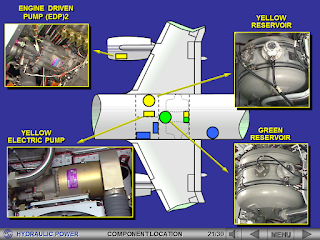The reservoir stores the hydraulic fluid. It supplies
fluid to the system through a pump and receives the return fluid from the system.
It accommodates the extra fluid caused
by thermal expansion and compensates
for slight leaks, which may occur throughout the system and provides a reserve supply of fluid for emergency
operation of systems which are essential for flight control and landing. There
are two types of reservoir such as vented
(unpressurised) and pressurised.
A vented reservoir is
the type normally fitted to a Piston-engine, un-pressurised, aircraft, which
would normally operate below 20,000 feet
altitude. The vented reservoir (unpressurised) is often constructed from welded aluminium alloy. The reservoir
is located at a higher level than the EDP’s to ensure a positive “head of pressure” supply of fluid throughout all normal
flight manoeuvres.
Pressurised Reservoir
is used to aeroplanes that fly at altitudes higher than 20 000 feet require the
hydraulic reservoir to be pressurised. This prevents foaming of the fluid due
to the low ambient air pressure at high altitudes, and by providing an
artificial head of pressure, helps to prevent pump cavitation in its inlet.
There are problems
occur in vented reservoir when aeroplane flying through turbulent air, negative
“g” forces or high roll angles, could cause a temporary loss of supply to the EDPs’
allowing them to “run dry”, resulting in pump inlet cavitation. This could seriously damage the pump and cause it to fail. To compensate for this, a low-pressure pump is sometimes installed between
the reservoir and the EDP’s to
ensure a positive head of pressure during such conditions.
There are several
sources in reservoir pressurisation such as cabin pressurisation air, engine Compressor/ Bleed air (LP) that
will be pressurise the system between 30
to 45psi depending on system design. Hydraulic system generated pressure
that will be provides the head of
pressure by system pressure acting on one side of a small piston attached
to the bottom of the main piston shaft, which exerts pressure on the fluid
through the main piston.


No comments:
Post a Comment